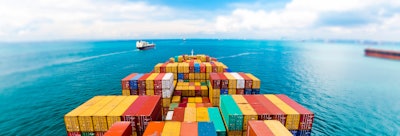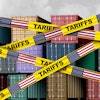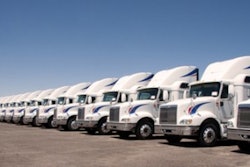
Since the beginning of the COVID-19 pandemic, companies around the world have been struggling to rebuild their global supply chains, both in terms of finding suppliers to deliver the key parts needed in their manufacturing and/or delivering end products to their customers.
The hundreds of small to medium-sized businesses housed within one of the 300-plus World Trade Center-branded facilities located across 92 countries have been experiencing firsthand the logistical and supply chain challenges that resulted from the pandemic.
Food Logistics’ editor-in-chief Marina Mayer sat down with Michele Porrino Perassi, executive director of World Trade Center San Luis Potosi in Mexico, to talk about post-COVID-19 pandemic challenges for maritime and air cargo, logistics challenges deriving from e-commerce and how nearshoring is an option for U.S. and Latin American companies to reconfigure their global value chains.
Food Logistics: 2022 saw a lot of instability within the supply chain. Port strikes, rail strikes, driver shortage and more. Industry experts even predict it may take supply chains close to 2-3 years to turn around. From your vantage point, what does the state of the supply chain look like next year and in the years ahead?
Michele Porrino Perassi: Since we are an industrial park in Mexico, very close to the U.S. market, offering exceptional services for any business wishing to expand or start operations, the logistic challenges during the pandemic are generating many opportunities for us. The “nearshoring effect” is a real thing. Companies are approaching us and other industrial parks to reduce logistics risks and increase logistics efficiency. Historically, the goal for manufacturing companies was zero inventory. The pandemic has changed that thinking. Now, many companies are trying to relocate all their manufacturing capacity from Asia. In some cases, when that’s not possible, they are relocating part of their capacity. And in other cases, companies cannot relocate manufacturing but can substantially increase their safety stock. These measures are helping, but they won’t reduce logistical challenges immediately. Even with just increasing safety stocks, you need warehouses, and there aren't enough in North America. The current vacancy rate in warehouses in Canada, the U.S., and Mexico are close to 0%. This process will take time. I believe it will take 1-2 years for companies to get to safer performance.
Food Logistics: Explain the importance of logistic hubs in relation to ports and distribution centers.
Porrino Perassi: It makes sense to relocate a business to a logistic hub to have different ways to access the market so you can be more efficient. For example, companies located in WTC Premium Industrial Park in San Luis Potosí, Mexico, have access to a good rail service connecting to truck routes in Mexico and the U.S. and a free trade zone that makes making and receiving shipments easier in an international environment. Our city also has a strong, established supply chain, making logistics very efficient. Being part of a global network such as the WTCA is extremely beneficial because there are over 300 WTC locations in over 100 countries.
Food Logistics: Explain some of the post-COVID-19 pandemic challenges for maritime and air cargo and what’s in store for 2023.
Porrino Perassi: Companies must be more creative. That may be finding better, more efficient routes. It could also be using combined processes (having part of your manufacturing done in Asia, part of it done in Mexico and part close to your market). You can also have some manufacturing done on the road (by rail, etc.) Looking years ahead, by using technology, such as 3D printing, companies may be able to have manufacturing done on-site and in real-time wherever they are located.
Food Logistics: Explain some of the logistics challenges deriving from e-commerce. Be specific.
Porrino Perassi: E-commerce has been increasing exponentially, and there are many challenges: lack of warehouse space (as I mentioned above), a shortage of drivers, dealing with reverse logistics (consumers returning items). I’m convinced that companies need to build a relationship with consumers and be able to suggest and explain more efficient ways to supply merchandise. There’s a lot of technology available that can enhance the experience for the customer while also improving logistics efficiently, and at the same time, taking care of the environment because that’s critical.
Food Logistics: When should companies opt for nearshoring?
Porrino Perassi: Yesterday! I don’t know of one company that isn't regretting having utilized nearshoring earlier. There is too much manufacturing capacity overseas. Having the biggest markets here in North America used to make sense, but not anymore. The questions are timing, money and feasibility of doing it. Some manufacturing processes are too expensive and complicated to move. For them, they are increasing safety stock. However, we are seeing all companies relocating as part of the process or part of their capacity. We are experiencing that every day.
Food Logistics: Which hubs and/or ports are experiencing the most innovation and why?
Porrino Perassi: Brownsville, Texas; it is the only city on the border with Mexico that offers five methods of international transportation: water, rail, highway, air and space. It stands out for its import-export operations and is a fast-growing manufacturing hub with solid infrastructure, logistics and valuable resources known for its pro-business climate. The Port of Brownsville is a deepwater seaport with approximately 40,000 acres and the largest land-owning public port authority in the nation. The City of Brownsville and its local companies are making significant investments in aerospace, technology, manufacturing, logistics and entrepreneurship development projects. SpaceX recently invested $500,000 to improve the 46,000-square-foot site it has leased at the Brownsville Aerospace Industrial Park.
Food Logistics: Which hubs and/or ports are experiencing the most challenges and why?
Porrino Perassi: Ports that have too much traffic face many issues. Larger ships, increased demand and lack of drivers for transport made the congestion worse. However, thanks to better planning, technology and other factors — such as decreasing shipping costs — we see a return to a more manageable situation.
Food Logistics: How has the relationship between commerce and trade changed since the pandemic?
Porrino Perassi: The most significant change is e-commerce. It was strong but increased exponentially during the pandemic. Consumers are now purchasing items online that used to be made in a more traditional, in-person manner, such as buying groceries.
Food Logistics: What’s in store for 2023?
Porrino Perassi: I see much activity in industrial markets, which is a good problem to have. There will be increased building capacity for warehousing and new manufacturing. It will be a significant challenge to the North American market. I also believe global thinking will move toward local thinking.
Porrino Perassi: We must be prepared for the unexpected and open to new technologies. There will be some factors that reshape our ways of doing business. It’s essential to be aware of technology trends because they reshape how we do business. There will be many changes in logistics because I believe individual transportation will go down. Change may make us uneasy, but we must be open to new concepts. In times of uncertainty, the importance of organizations like the WTCA that help small- and medium-sized organizations expand their global reach becomes even more pertinent.




















